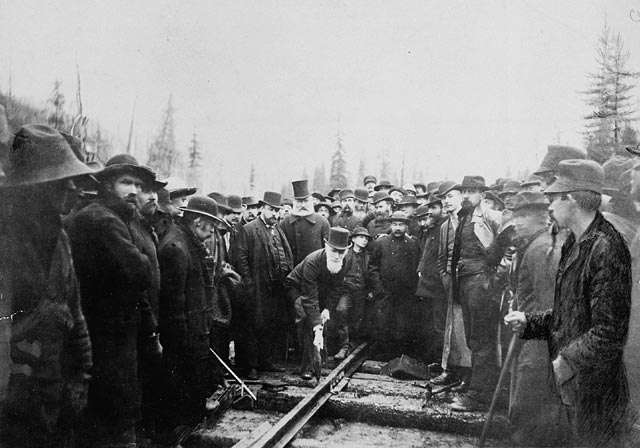The Priceless Rail-Line
Many Canadians mark the 1885 completion of the trans-Canadian railroad as a proud historical moment. Canadians cherish the achievement because they appreciate how difficult the construction was, but they apparently fail to remember how arduously stubborn the political obstacles were.
As Pierre Berton illustrates in two books, The National Dream and The Last Spike, opposition was rife; ardent foes formed political coalitions to stymie the project, and failure was predicted, even though the rail-line soon became invaluable. It allowed us to maintain law and order during the North-West Rebellion, in maintaining a Canadian presence along the western-section of our south border, and in populating our broad and bountiful Prairies. Indeed, the photograph of Sir Donald Smith driving the ‘Last Spike’ into the ground in Craigellachie, British Columbia is one of Canada’s most iconic images.
A Blasphemous Project?
The simple truth is that all great projects start off as blasphemous, but – with the exception of a few ludicrous anomalies – these projects laid the economic foundation of the surrounding area. When New York Governor DeWitt Clinton proposed the construction of the Erie Canal in 1809, then-President Thomas Jefferson called it “a little short of madness” and it was mocked as “Clinton’s Folly”.
However, once constructed, the canal cut the transport costs between the Great Lakes and New York by an astounding 95%. It is no exaggeration to say that this solidified the city’s place as America’s principle transportation hub and consequently commercial hub. Similar stories can be told regarding the St. Lawrence Seaway or about a whole litany of other transport, energy, utility, and telecommunications infrastructure projects.
 Only when we consider that more trade crosses the Detroit-Windsor Ambassador Bridge than the combined sum of US – Europe and US – Japan trade, does one realize how dependent we are on these infrastructure projects (incidentally, the bridge needs an upgrade).
Only when we consider that more trade crosses the Detroit-Windsor Ambassador Bridge than the combined sum of US – Europe and US – Japan trade, does one realize how dependent we are on these infrastructure projects (incidentally, the bridge needs an upgrade).
In fact, many parts of the emerging world have learned this secret and are building their futures at a furious pace. They are laying the foundation for economic vitality with blisteringly fast trains in China, new rail and road networks in India, and added offshore energy development in Brazil.
So, how are we keeping up?
Well, while the Chinese Government recently announced that the ports around Shanghai will be receiving another $1.5 billion for their expansion, all of Canada’s Pacific ports combined will have to split less than half that sum and they’ll have to stretch it over the next ten years. While Beijing opens a new airport that can handle 60 million passengers a year, tedious concerns prevent the expansion of Vancouver’s airport.
As well, while the Chinese and Russians are working towards a pipeline that could be over 8,000km in length, the MacKenzie Valley Pipeline spent 35-years in the approval process. British Columbia’s former Transport Minister, Kevin Falcon, noted that we are falling back mainly because of our excessively onerous approval process. Given China’s quick and determined permitting procedures, they would complete a project before we are even halfway done discussing a proposal. Sadly, a Member of the Legislative Assembly of British Columbia, Ralph Sultan, revealed that the time spent trying to get a mine approved can be longer than the entire estimated economic-lifespan of the mine.
Decision Power Shifts
All of which is why I was heartened to hear Canada’s Natural Resources Minister Joe Oliver pushing forth legislative changes that would place decision making over infrastructure projects, in this case energy infrastructure projects, in the hands of the Cabinet, instead of administrative bodies, such as the National Energy Board (NEB). Bodies like the NEB are often caught up in their obligations, under administrative law, to hold endless hearings and public consultations. These consultations can get stuck in the apparent blasphemy of the initiative. Despite the fact that proposals like the Northern Gateway pipeline possess impeccable engineering bona fides, any discussion of it with the opponents of the project garners an almost Pavlovian reference to the Exxon Valdez – oil’s version of Godwin’s law.
By these standards, if approval for the Trans-Canada Railroad, or the Erie Canal, were up to an administrative-technical board to assess, they probably never would have happened. In the 1870s, various committees thought it impossible to blast through the hard-rock in the Canadian Shield, many others wondered why it was desirable to even run a railway through (what was then) empty prairie. Instead, it takes vision and leadership.It was only because Prime Minister Sir John A. MacDonald vigorously employed nearly all his political capital towards the project that the promise that he made to British Columbia was kept, and the dominion was maintained. The same thing is true for ‘Clinton’s Folly’.

Canada’s Moon?
Minister Oliver has designed the legislative change such that the (NEB) will continue to prescribe conditions and parameters to projects (as fits the purpose of a body of technical experts), and that’s an excellent formulation, but the change also recognizes that leaders need to lead. Our leaders need to do what President John F. Kennedy did when he said that Americans would walk on the moon before the 1960s are over.
Reaching Our Potential
In Canada, our leaders need to say that we will also soon have some of the best airports possible. Our leaders need to say that it is no longer acceptable that, even though Prince Rupert is two sailing days closer to Shanghai than the port of Long Beach is, capacity and infrastructure challenges limit the desirability of using Canadian infrastructure to reach central and eastern North American markets. Ultimately, we, as a country, need to seriously consider how to alleviate the impediments that prevent us from implementing a prosperous vision for the future. With changes like the one brought forth by Minister Oliver, and, with enough elbow-grease, we can build a stronger future.
Our future-selves will thank us for it.



